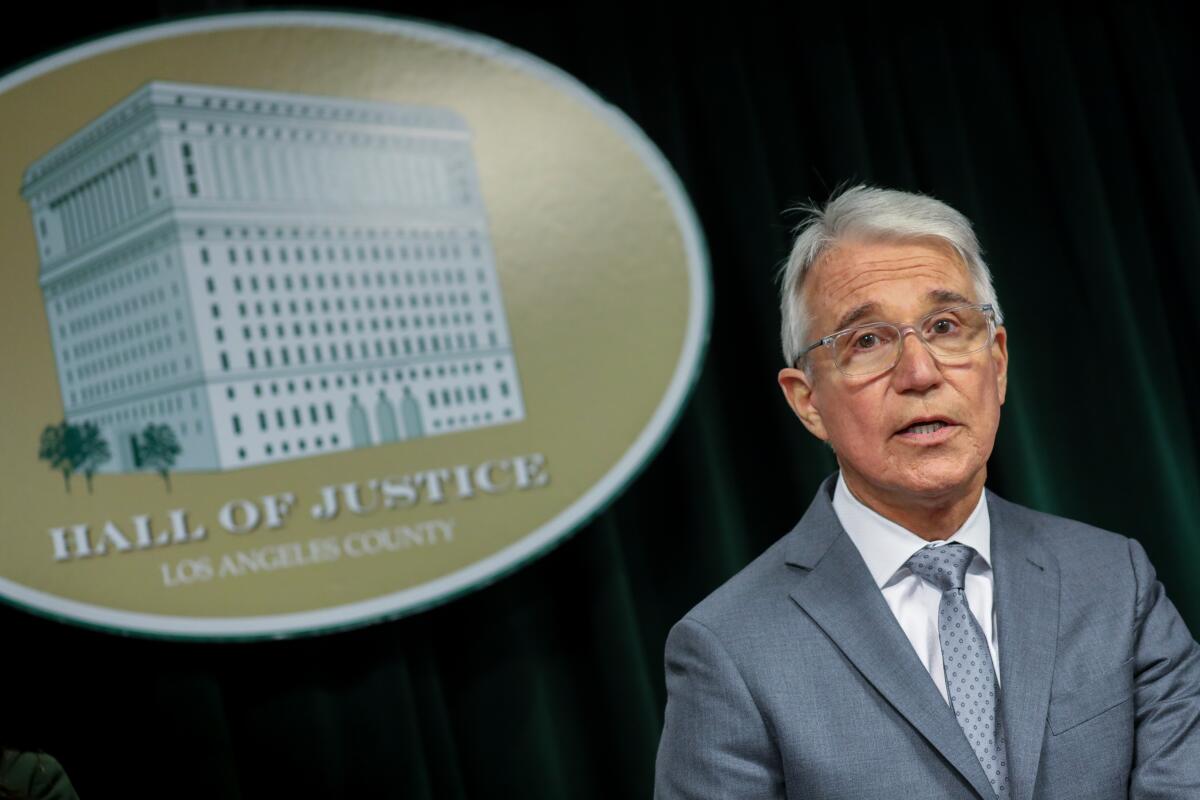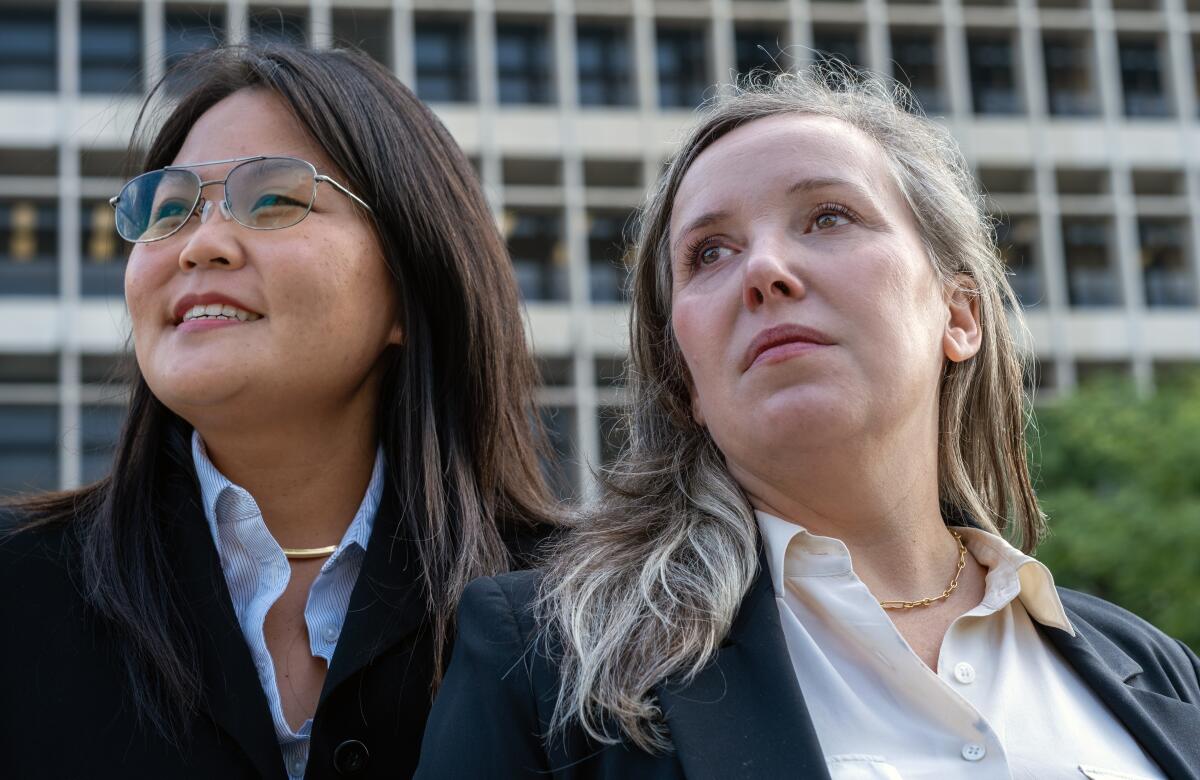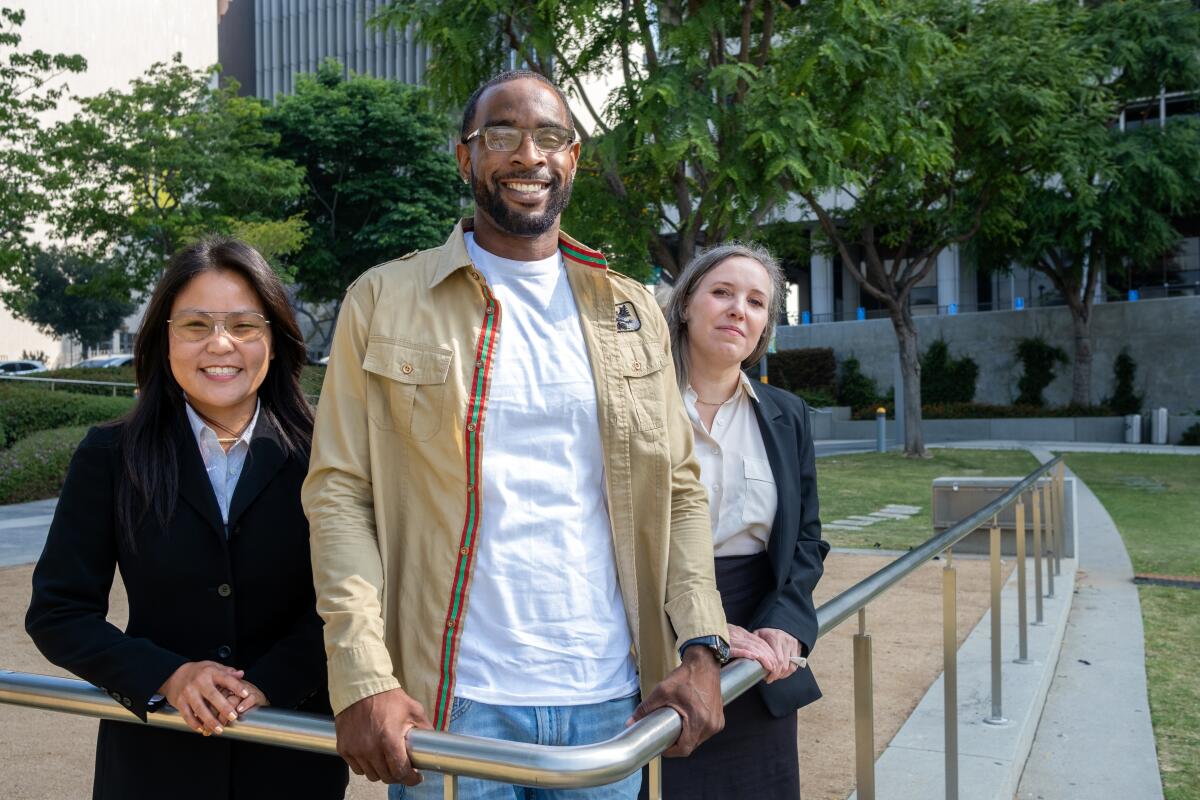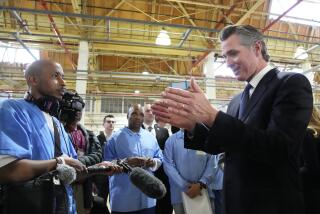Frustration and criticism as L.A. County D.A. struggles to reform sentencing

- Share via
Barry Hawes cuts a fierce figure, all lean muscle and sharp angles built on the frame of a onetime high school wide receiver. But when Hawes was sent to prison at age 16 for his connection to a fatal shooting, he was still a boy among men.
Over the next 17 years of his 25-year sentence, he said, he was stabbed and suffered multiple broken bones while fighting for survival behind bars.
Hawes maintains his innocence. But charged as an adult and facing life in prison for felony murder, he took a plea deal at the urging of his family. He recalled his father’s words: “I’d rather you take 25 years and have a [release] date, or you have life and now you never come home.”
In the years since, a witness has come forward to identify someone other than Hawes as the shooter. And with changes in California law that now make it rare for a juvenile defendant to be tried as an adult — as well as sentencing reforms promised by Los Angeles County Dist. Atty. George Gascón — the 34-year-old Hawes considered himself an ideal candidate to have time shaved off his prison sentence .

On his first day in office in 2020, Gascón unveiled a list of seismic policy shifts including the creation of a resentencing unit that he said could reduce the terms of up to 30,000 people sent to California prisons by L.A. prosecutors under what he called outdated policies. But as of mid-July, only 95 people vetted by that unit have been resentenced, according to data provided to The Times in response to a public records request.
Although Hawes has been released from prison under another program, his was among the dozens of cases denied or left pending by Gascón’s dedicated resentencing team during its first 2½ years of operation. Gascón has said he wants to reevaluate the cases of many defendants similar to Hawes who have served more than 15 years in prison, been tried as adults for crimes committed under the age of 17, or seen their sentences greatly increased by so-called enhancements, which add punishment for alleged gang affiliation and other factors.
While supporters say Gascón’s attempts to provide post-conviction relief are still a major improvement over the prior administration, the slow pace has drawn a mix of frustration and criticism from defense attorneys and reform advocates who expected more from the “godfather of progressive prosecutors.”
Some have expressed concern that constant discord in the office, including two failed recall attempts, has made staff hesitant to take action.
“They’re worried about having their names on briefs when someone is released,” Michael Romano, chair of Gov. Gavin Newsom’s committee on revising the penal code and a former advisor to Gascón, said of some prosecutors in the resentencing unit. “They’re very concerned about recidivism.”
Despite Gascón’s comments about thousands of people needing to be resentenced, the unit is still working off an initial list of 400 cases it was asked to review. Of those, prosecutors have sought resentencing in 162, according to the records provided to The Times. The unit declined to pursue an additional 122 cases, and roughly 100 are still awaiting a decision by the resentencing unit or a judge.

Of the 95 defendants who have been resentenced, many were serving 25 years or longer for burglary, robbery or being a felon in possession of a gun, records show, with enhancements often adding significant time to their prison terms. The use of enhancements, which data show disproportionately affect Black and Latino defendants, is sometimes criticized as a relic of 1990s “tough on crime” policing and often blamed for the state’s massive prison overcrowding issues.
Tiffiny Blacknell, a spokesperson for Gascón’s office, defended the resentencing initiative and said the number of people who’ve benefited is “greatly multiplied” if expanded to include the work of other units in the office. She pointed to cases in which defendants were released for medical reasons, death penalty cases that were reduced to life without parole, and others affected by the office’s use of California’s prosecutor-initiated resentencing law, which took effect in 2019.
Blacknell said the office has helped resentence 207 defendants under that law — a figure they say far outpaced those of other large counties in California — but did not provide exact figures for other forms of resentencing.
Blacknell also said that it had taken a number of months to get the unit up and running during the tumultuous beginning of Gascón’s term, a period marked by lawsuits and public criticism from many of his own prosecutors.
Another factor is the broader staffing crunch in the L.A. County court system. The district attorney’s office had only 808 prosecutors as of mid-June, its smallest roster in decades. The resentencing unit has only three full-time deputy district attorneys at the moment, Blacknell said.
While reform advocates and attorneys have lauded Gascón’s intent, they say the unit has failed to aid anywhere near the number of defendants that it could, rejecting Hawes and others who seemingly meet the criteria.
Frustrated with the system
Hawes said he was selling drugs by age 15 and “running the streets” of the Antelope Valley community where he grew up. In 2005, one of his older customers let Hawes borrow his car. Hawes was pulled over for driving without a license after buying a necklace as a Valentine’s Day present for his then-girlfriend, and police returned the car to its owner, Darryl Watkins, with the gift inside, according to court records and Hawes.
The next day, Hawes and his friends came looking for the jewelry. A fight broke out and, according to Hawes’ attorney, another participant in the melee shot Watkins.
“I was shocked. I was upset. I yelled out, ‘Why the f— did you shoot him for?’” Hawes said.
Hawes was charged with felony murder because he was involved in the fight that led to the shooting, a crime he could not be charged with today under changes to California law. According to Hawes’ attorney, Bess Stiffelman, prosecutors had no direct evidence that her client had killed Watkins at the time of his arrest. Eighteen months later, Los Angeles County sheriff’s investigators produced a witness who said Hawes was the killer. The witness’ brother was also a suspect in the case, and Stiffelman noted that the identification of Hawes shifted the blame.
The lone witness was never cross-examined, according to Stiffelman.
Hawes’ name appeared on the list of 400 cases for sentencing review , records show, but it was rejected.
The experience left Hawes frustrated with the system.
“I gave up a few times,” he said. “They took 25 years [from me]. What more can they do?”
Stiffelman and other defense attorneys who have had cases rejected by the resentencing unit said prosecutors are afraid to take action.
“Even people that were committed to doing this work are going to be fearful of political backlash,” Stiffelman said. “It’s much easier to deny someone than to grant it.”
Stiffelman said the unit rejected Hawes’ bid for resentencing in part because his probation report erroneously claimed he had been accused of assaulting a child. Hawes was never arrested or charged in that case, she said.
Blacknell contended that error did not play a significant role in the unit’s decision. Instead, she said, Hawes’ conduct in prison and the fact that an eyewitness accused him of firing the gun made him unsuitable for resentencing. Blacknell also said the unit is meant to prioritize inmates serving long sentences for “nonserious, nonviolent, non-sex offenses” who are over the age of 50 “because those individuals are generally believed to be less likely to recidivate,” as well as juveniles charged as adults who would not be today.
In practice, lawyers who handle post-conviction cases say Gascón is going only after “low-hanging fruit” by focusing on nonviolent offenders. Defense attorney Andy Stein remembers getting dozens of phone calls around the time of Gascón’s swearing-in from people facing the kinds of lengthy sentences that his policies were meant to help. But he said he’s been able to aid only a few.
“I think the public has a total misconception of what’s going on,” Stein said. “He’s not letting tons of people out, he’s letting hardly anybody out. … The road to hell is paved with good intentions. He’s under-equipped, underfunded.”
While appreciative of Gascón’s efforts overall, Hawes ended up serving 18 more months in prison after the resentencing unit denied his petition. He said the added time was a final jab on a trip through the criminal justice system that has left him battered and bruised.
“The only thing that’s in here is violence, and I refused to fall victim to it,” Hawes said. “I had to match aggression with aggression.”
Records provided by Stiffelman show Hawes was served with eight disciplinary violations while in prison, five of which were for fighting, most recently in 2017.
To get by, Hawes said, he tried to fill up his days with activities. Bible courses. Anger management. He returned to sports during yard time, trying to measure his sentence in pickup games instead of years.
“I did every program in any prison I went to, whatever they had to offer,” he said. “I was just always learning, always kept myself busy. I always worked out or played basketball. … As long as I get on the court nothing else matters. It’s just about winning this game, just day to day trying to escape my own head.”
No resources, no prospects
Among those who did get a sentence reduction through the efforts of Gascón’s unit is Johnny Guevara.
In 1998, when he was 15, Guevara pleaded guilty to kidnapping and carjacking in a deal that sent him to prison for life with the possibility of parole, records show. His co-defendant, who turned himself in, was tried as a juvenile and sentenced to just four years in prison for the same conduct.
The pair had run up behind two brothers at an ATM in La Puente and forced them into their car using replica guns, court records show. They robbed them and ordered the victims to drive to a warehouse, where they bound them with duct tape and left, according to court records. Neither victim was injured, and the proceeds of the robbery were $40, court records show.
Guevara said he still feels awful about what he did, but can’t believe he was sent to prison for life over a crime he committed as a teen.
“In no way am I minimizing the impact that I’ve had on their lives,” he said. “To this day, for all I know, they’re still looking behind their back when they’re driving around late at night.”
Christopher Hawthorne, director of the Juvenile Innocence and Fair Sentencing Clinic at Loyola Law School in Los Angeles and Guevara’s attorney, said the case highlights the successes and importance of Gascón’s program, even if he wished it would move faster. But he also said the unit has “under-delivered,” in part because of fears about how former inmates will adjust to life after prison.
“I certainly understand their caution,” Hawthorne said. “No one wants someone to get out having no resources, having no prospects and having a bad experience or a crackup.”

Hawes was released last July under a change in the law that affects defendants convicted of felony murder, after a lawyer in a different unit in the district attorney’s office agreed that there was not enough evidence to prove he shot Watkins.
He has come home to a strong support network, splitting his time between Lancaster and Los Angeles while working for his father’s trucking company.
“Life is good. I’m in the best place,” Hawes said. “I’m peaceful. I’m getting along with my family. I skip through work having fun.”
But, he said, he knows many people with similar life stories who deserve the resentencing unit‘s attention — and they still wake up in a cell every morning.
Times staff writer Keri Blakinger contributed to this report.
More to Read
Sign up for Essential California
The most important California stories and recommendations in your inbox every morning.
You may occasionally receive promotional content from the Los Angeles Times.














